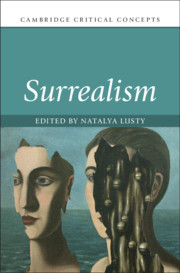Book contents
- Surrealism
- Cambridge Critical Concepts
- Surrealism
- Copyright page
- Contents
- Illustrations
- Notes on Contributors
- Acknowledgments
- Introduction: Surrealism’s Critical Legacy
- Part I Origins: Ideas/Concepts/Interventions
- Part II Developments: Practices/Cultures/Material Forms
- Chapter 7 Surrealist Collections in Paris and Sussex
- Chapter 8 Surrealist Objects
- Chapter 9 Collage
- Chapter 10 Film
- Chapter 11 Photography in Surrealism
- Chapter 12 Surrealist Fashion
- Chapter 13 Surrealist Display Practices
- Part III Applications: Heterodoxies and New Worlds
- Select Bibliography
- Index
Chapter 10 - Film
from Part II - Developments: Practices/Cultures/Material Forms
Published online by Cambridge University Press: 23 July 2021
- Surrealism
- Cambridge Critical Concepts
- Surrealism
- Copyright page
- Contents
- Illustrations
- Notes on Contributors
- Acknowledgments
- Introduction: Surrealism’s Critical Legacy
- Part I Origins: Ideas/Concepts/Interventions
- Part II Developments: Practices/Cultures/Material Forms
- Chapter 7 Surrealist Collections in Paris and Sussex
- Chapter 8 Surrealist Objects
- Chapter 9 Collage
- Chapter 10 Film
- Chapter 11 Photography in Surrealism
- Chapter 12 Surrealist Fashion
- Chapter 13 Surrealist Display Practices
- Part III Applications: Heterodoxies and New Worlds
- Select Bibliography
- Index
Summary
Luis Buñuel and Salvador Dalí’s Un chien andalou (1929) and L’âge d’or (1930) are often considered to be both the beginning and the end of surrealist cinema. But such hasty contentions obscure a rich tradition of surrealist filmmaking. This chapter discusses the defining characteristics of Buñuel and Dalí’s pioneering films, before proceeding to demonstrate that while the broader surrealist film tradition is notably indebted to these early experiments, it is also marked by an astounding heterogeneity. Surrealist filmmakers in France, Belgium, and Czechoslovakia have employed a range of formats, including documentary, feature film, and animation, from the 1930s up to the present. Providing an overview of surrealist film in a wider context, the chapter looks at how Michel Zimbacca’s documentary films interrogate notions of Western supremacy, Nelly Kaplan’s feature films depict anarchic revolts against patriarchy, and Jan Švankmajer’s films use animation to give life to inert matter in inventive ways.
Keywords
- Type
- Chapter
- Information
- Surrealism , pp. 191 - 207Publisher: Cambridge University PressPrint publication year: 2021



